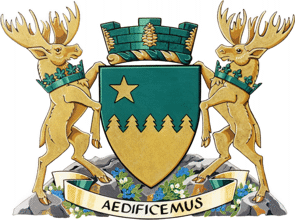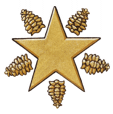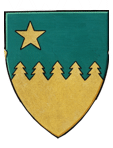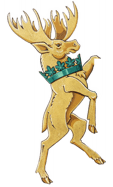City Crest
Colours
 The primary colours are green and gold. Vert or green in heraldry symbolizes - hope, joy and loyalty. The origin of the word "green" lies in the ancient word "ghro" which means "grow and prosper". The White Pine (an evergreen), which features prominently in the crest, stands for longevity and immortality. The City's Corporate Visual Identity Standards Manual states: "Green is a colour which traditionally conveys "growth" and "harmony". It is also appropriate seeing as Sudbury has positioned itself on the world stage as a leader in regreening." Green therefore also symbolizes a healthful environment.
The primary colours are green and gold. Vert or green in heraldry symbolizes - hope, joy and loyalty. The origin of the word "green" lies in the ancient word "ghro" which means "grow and prosper". The White Pine (an evergreen), which features prominently in the crest, stands for longevity and immortality. The City's Corporate Visual Identity Standards Manual states: "Green is a colour which traditionally conveys "growth" and "harmony". It is also appropriate seeing as Sudbury has positioned itself on the world stage as a leader in regreening." Green therefore also symbolizes a healthful environment.
The colour gold is associated with generosity, reason and immortality. It is also one of the most precious metals in the history of mankind; a precious metal that is able to stand the test of time. Pure gold is little affected by exposure to the elements and does not deteriorate. Like gold, the spirit of community does not deteriorate but is able to stand the test of time. The use of "gold" is also representative of the mineral rich nature of Greater Sudbury.
Star
Positioned within the Crest proper, is a traditional five pointed golden star. The north star is a traditional guide for navigation. The north star is also symbolic of Greater Sudbury as the leading City of northeastern Ontario, the "hub of the north", "ever expanding community, indeed, its  educational, medical and administrative capital. A five pointed star can also represent the characteristics of a good citizen, which are: Fortitude, Loyalty, Righteousness, Prudence, and Broad-mindedness.
educational, medical and administrative capital. A five pointed star can also represent the characteristics of a good citizen, which are: Fortitude, Loyalty, Righteousness, Prudence, and Broad-mindedness.
Again, the Corporate Visual Identity Standards Manual states: "One can interpret the star as also meaning "bright", "new", "dynamic", diverse", "spirit of community" or "star of the north".
Shield Elements
 The elements to be included in the Shield include a stylized coniferous tree division. This represents the original old growth white pine forests that once covered this area of Northern Ontario. It also symbolizes the lumber industry, one of the original industries of the area, and also the regreening efforts of the past quarter century, the effect of which will be most evident in this century. This stylized coniferous tree division also reminds our Citizens that this vast forest was a treasure, but sadly, it was not treasured. The white pine also serves as a reminder of the vast regreening that has been undertaken over the past thirty years and honour those who participated in that undertaking.
The elements to be included in the Shield include a stylized coniferous tree division. This represents the original old growth white pine forests that once covered this area of Northern Ontario. It also symbolizes the lumber industry, one of the original industries of the area, and also the regreening efforts of the past quarter century, the effect of which will be most evident in this century. This stylized coniferous tree division also reminds our Citizens that this vast forest was a treasure, but sadly, it was not treasured. The white pine also serves as a reminder of the vast regreening that has been undertaken over the past thirty years and honour those who participated in that undertaking.
When people view the crest, they think of Sudbury as a community that both cared about and protected its environment. Also prevalent in the design is the use of pine cones, which not only convey the sense of new beginning and future growth but also serve as a recognitions of Sudbury's original name which was Ste Anne des Pins. The bottom or "compartment" of the Shield is composed of mineral rock with blueberries growing. These two elements represent the mining industry and agriculture. However, the rock of the compartment can also symbolize the strong and enduring foundations upon which this community has been build and blessed.
Wrapped around the base of the compartment is the City's official motto, which can be translated from the Latin as: Come, Let us build together - in English and Ensemble, bâtissons notre avenir - in French.
Supports
The two supports on either side of the shield are Northern Moose each with unique collars. The moose is a unique and mighty symbol of Northern Ontario. With their bountiful beauty and strength, they can inspire one  with a sense of awe for Nature's majesty. Despite their size and strength, moose tend to act very kindly toward their environment. Moose treat other animals and their surroundings with quite respect and care. The moose on the left is adorned with a collar of green maple leafs. These maple represent the cultural diversity of Greater Sudbury; the various peoples of the world and those from different parts of Canada that have gathered and met in Greater Sudbury to create a unique multi-cultural community, and in the process have build new lives and new beginning for themselves and their posterity, an created a unique and prosperous community.
with a sense of awe for Nature's majesty. Despite their size and strength, moose tend to act very kindly toward their environment. Moose treat other animals and their surroundings with quite respect and care. The moose on the left is adorned with a collar of green maple leafs. These maple represent the cultural diversity of Greater Sudbury; the various peoples of the world and those from different parts of Canada that have gathered and met in Greater Sudbury to create a unique multi-cultural community, and in the process have build new lives and new beginning for themselves and their posterity, an created a unique and prosperous community.
The moose on the right is adorned with a collar of fleurs-de-lis. This collar represents the Francophone populace of Greater Sudbury and the bilingual nature of the new City of Greater Sudbury. The fleur-de-lis was the first heraldic emblem raised in Canada. On July 24, 1534, Jacques Cartier landed as Gaspé and erected a cross, affixed with the symbol of his sovereign and the royal house of France.
Mural Crown
 Topping the crest is the mural crown. The mural crown is a plain circlet of battlements on a narrow rim, encrusted with pine cones. The mural crown is supposed to have been given by the Romans to the soldier that first mounted the breach in the wall of a town or fortress. It would also apply to the defender of a town or fortress. This battlement represents the City Walls. It is common to coats of arms granted to municipalities, in that it represents the City's responsibility to shelter and protect its citizens.
Topping the crest is the mural crown. The mural crown is a plain circlet of battlements on a narrow rim, encrusted with pine cones. The mural crown is supposed to have been given by the Romans to the soldier that first mounted the breach in the wall of a town or fortress. It would also apply to the defender of a town or fortress. This battlement represents the City Walls. It is common to coats of arms granted to municipalities, in that it represents the City's responsibility to shelter and protect its citizens.
The intertwining collar at the base of the wall, symbolizes added strength when working together. All these three elements when combined are most appropriate if one considers the origin of the municipality and its motto. .
Motto
A motto is defined as an expression of conduct (or, maxim) adopted as a guiding principle. The suggested motto for the new City is adapted from the Book of Nehemiah: "Come, let us build together". In this particular passage Nehemiah was asked by God to rebuild the city walls of Jerusalem which had crumbled. After appraising the damage, Nehemiah appreciated that the job could not be done by one person alone but would require the collective efforts of Jerusalem's citizens.

It has been said that Nehemiah was the first practitioner of the politics of inclusion. The suggested motto is one that would serve to recognize that building and maintaining a community is an never ending task and one that we, as citizens, are obligated to contribute and continue. This motto also is a recognition of all those who have settled and built the community we have inherited through their efforts.
